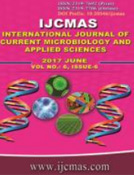


 National Academy of Agricultural Sciences (NAAS)
National Academy of Agricultural Sciences (NAAS)

|
PRINT ISSN : 2319-7692
Online ISSN : 2319-7706 Issues : 12 per year Publisher : Excellent Publishers Email : editorijcmas@gmail.com / submit@ijcmas.com Editor-in-chief: Dr.M.Prakash Index Copernicus ICV 2018: 95.39 NAAS RATING 2020: 5.38 |
Root rot is one of the major problems adversely effecting the growth of fir (Abies pindrow) seedlings in Kashmir valley and the study was conducted to find out the cause of the disease. The disease was prevalent in all the three fir growing nurseries surveyed with disease incidence 32.2 and 29.3 per cent during 2013 and 2014, respectively. The pathogens associated with the disease were isolated, morphologically characterized and identified as Fusarium oxysporum f.sp. pini, Fusarium solani, Fusarium pallidoroseum, Rhizoctonia solani, Sclerotium rolfsii and Pythium sp. Fusarium oxysporum f.sp. pini was most predominant pathogen with isolation frequency of 30.0%, whereas F. solani. F. pallidoroseum, R. solani, S. rolfsii and Pythium sp showed isolation frequencies of 22, 18, 12, 10 and 8% respectively. All the fungi proved pathogenic and caused characteristic symptoms when inoculated separately. Among the various fungitoxicants evaluated against these pathogens during in vitro studies carbendazim and mancozeb exhibited maximum mycelial growth inhibition of 80.5 and 73.2 per cent, respectively. Various antagonists and ectomycorrhizal fungi evaluated through dual culture tests inhibited the growth of pathogens with varying degrees of inhibition. Among antagonists Trichoderma harzianum TG1 and Trichoderma viride TG2 and among the ectomycorrhizal fungi Laccaria laccata and Boletus edulis were most effective and showed mycoparasitic action and also developed zone of inhibition. During in vivo studies, fungitoxicants (carbendazim and mancozeb), antgonists (T. harzianum TG1and T. viride TG2) and ectomycorrhizal fungi (L. laccata and B. edulis) used individually or in combination resulted in significant reduction in root rot intensity of fir seedlings. In comparison to control treatments resulted in a significant increase in growth parameters viz., shoot and root length and in turn increased the plant biomass. Bio-agents were at par with each other in respect of plant growth when evaluated individually. Bio-agents in combination showed synergistic growth promoting action and were superior in increasing shoot and root length of inoculated fir seedlings. Fungitoxicants individually or as component of treatment combination were significantly superior to bio-agents used singly or in combination. Among the fungitoxicants, carbendazim individually or in combination was significantly superior to mancozeb in reducing the disease intensity. Among the treatments, combination of T. harzianum, + L. laccata + carbendazim proved significantly superior to all the treatments with respect to reduction in disease intensity and increase in growth parameters and sturdiness quotient.
 |
 |
 |
 |
 |